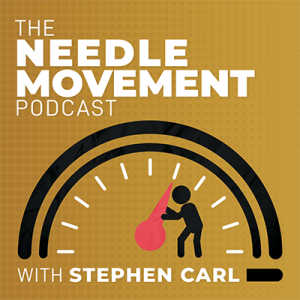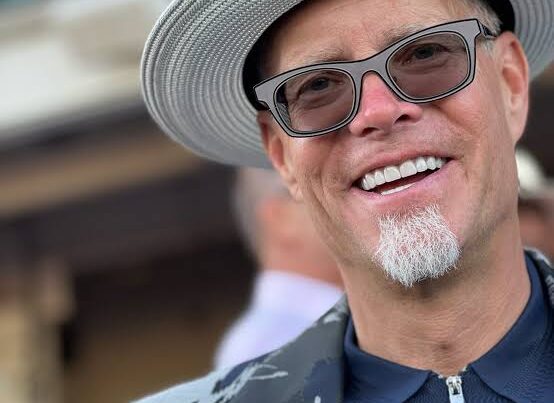Podcast: Play in new window | Download
Subscribe: RSS
What do conscious consumers want from you and how can you give it to them?

Stephen Carl
Stephen Carl is the founder of Needle Movement, a digital strategy company focused on conscious eCommerce. Stephen began his digital career as an early employee at an Amazon-funded start-up in 1998 and has been chasing online conversions ever since. His past digital marketing experiences cover a wide array of categories: not-for-profit, luxury fashion, home, and horticulture – all with the common thread of translating early digital trends into revenue growth.
With Needle Movement, Stephen decided that his true calling was to take part in the greater good – the emerging wave of retail brands that make a real difference through sustainability and social impact.
He helps these mission-driven brands navigate the wild world of digital marketing, steering them towards the big wins and away from expensive mistakes.
Stephen lives in Brooklyn, is a vegetarian and tends to get animated when discussing single-use plastics. He has had previous speaking engagements at Luxury Interactive, SearchCon and Predictive Summit.
What We Discuss With Stephen Carl In This Episode
- Current trends in conscious ecommerce and digital marketing
- How to become known as a conscious ecommerce company
- Maximizing the effectiveness of your email marketing sequence and overall strategy
- Social media and content creation tips for engaging your audience
- How to move the needle and build on the current success of your business
Episode Transcript Highlights
The eCommerce Landscape Today
I’ve been working in ecommerce since 1998. I started out in an Amazon-funded startup that was focused on one-hour delivery. Now over 20 years later, I’m doing digital strategy consulting for brands.
There’s been a fascinating transformation in the industry where there’s a build-out of a brand of consumer called the Conscious Consumer.
Ecommerce was always about instant gratification – people wanting things instantly. That’s why Amazon Prime is so popular.
Now with conscious consumerism, brands have to listen and figure out how to differentiate themselves. Sometimes differentiating yourself on price doesn’t work because someone can always lower the price on their product.
Because the consumer now has so much choice, they’re starting to talk about their values. A side effect of social media where brands are talking to shoppers as people is that it’s a two-dialogue. Consumers want that brand to be a person and they want to buy from brands that have the same values as them.
Brands are discovering that, by showing their values and their commitment to their mission and purpose besides just selling stuff, there are customers that seek that. They want to support companies that give to charity and have sustainability initiatives.
Conscious eCommerce verses Green-Washing
In terms of percentage (of consumers who seek conscious brands), it’s probably around 15% right now, but you have different shades of it. You have people who are very passionate about it, and then you have people who are more influenced by it.
Look how quickly plastic pollution and the backlash against it has gone mainstream. There are some who will have zero plastic in their home and there are others who are thinking about it and asking, “OK how do I reduce my plastic consumption by 50% and start using reusable things?”
So I’d say there are 15% that are in it, and 15% that are on the cusp.
In terms of green-washing and marketing, people have very good BS detectors these days, especially younger audiences who can smell an ad from a mile away.
I don’t think consumers expect perfection from organizations, rather they expect progress. Even with sustainability, they want to do business with companies that are thinking about it and how to do it better.
An example of green-washing is saying your product is vegan but not really espousing the values that go with it. It’s like highlighting your good side without showing your not-so good side. Another example could be having one product that is sustainable and the rest of your product line is not.
Shifting To Conscious eCommerce
I don’t want to imply that there’s this ultra-high bar. Everyone starts somewhere and I think the consumer rewards progress.
Regarding the marketing playbook for mission-driven brands, a lot of marketing is about storytelling. It gives us something to talk about rather than just products or “buy my stuff”.
A lot of brands are already giving to charity. It’s calibrating it into the message where you say, “These are the things we’re passionate about” and from time to time that can be mentioned in your marketing collateral.
If you’re posting on social media about your product, maybe every 3 weeks or once a month there’s a message about what you’re passionate about as an organization. It could also be a case study about what your organization has done.
On websites, the “About Us” page is often the last page that companies think about. But it’s an opportunity to give your bio and talk about the things that you’re really passionate about and the causes you believe in.
On the product pages, that’s where the product description and the “add to cart” button is, and where the consumer makes their buying decision. For sustainable companies, for example a jeans company, they could share a story about where the jeans were made.
They could have things called seals and badges. A badges could be “free shipping” with a little truck. That could be a trust badge. For a beauty brand, “cruelty free” or “vegan” could be a trust badge.
For email subscriptions – whenever someone signs up, there’s a sequence called the welcome series. That’s your chance to tell people all about you and the things that differentiate your company.
A popular strategy is a letter from the founder that sends a message to that subscriber that they’re important and you’re listening to them.
As brands, we learn so much from the shoppers themselves – what they like and what they don’t like. Having that open communication as the owner or founder of the business is great.
The blind spots are the scariest things in business, where there’s a problem but you don’t know about it.
Email Marketing and Social Media Tips
You want to identify the top reasons that people don’t use your product or service. Then your email provides the answers to them. For example, if people are concerned about price, you can address that. Or if people are concerned about sustainability, you can have a long conversation about that.
The first email could be a celebration of their sign up into the community. It’s also getting people to sign up to other social channels because you want to get people to sign up to multiple channels so they’re more engaged with your message.
Then there is the letter from the founder. You can also talk about how your product is made, or talk about the service you offer and give some detail. A lot of people like to give social proof, which is customer reviews. If you have best-selling products, you can feature them in a welcome series.
Going back to the debate about email – I know email is alive and well because during the last holiday season, the retailers were killing it on email. I’m seeing retail brands make 15x to 100x return on their investment in email.
Where it’s evolving is that brands want to have conversations with customers. Email is just the way you have that conversation. It’s a very fluid communication channel.
Whatever you’re creating, you’ve got to see it from the perspective of the recipient.
If you’re selling plants, the recipient isn’t buying plants every week, but you could give them plant care tips. The next time they’re going to buy plants, they’ll appreciate the value given in those tips.
A lot people are now sending text only emails. They are not sending logos and images; they are broadcasting a quick question that looks just like an email that a friend would send to another friend. For example, as a digital marketing strategist I might ask, “What is your most burning question about conscious ecommerce? What should I talk about next?”
Another example is, “What did you think about that?” because the feedback loop is really important.
Personally, I’m not posting on social media on a daily basis. I think people have to do what they’re comfortable with. It’s better to create good content on a less frequent basis (less than daily) than to create mediocre content that’s not going to hit everyone.
I’ve had good experiences with copywriters after I got past my pride (as an English major thinking I should do it). I’d do a rough draft about what I wanted to say and then the professional would make it stronger and really get to that vision that I wanted to get to.
It’s not about replacing roles, however sometimes finding collaborators can help us along the way. What’s nice about the gig economy is that the cost can be much lower to find relationships that allow you to scale the content that you’re creating.
Why Is It Called The Needle Movement
It’s a variation of “Move The Needle.” I was never that focused on what caused the impact, and I think in digital marketing we have these silos where we’re trying to credit one thing with the sale. Who cares, from the owner’s perspective? I just want to find the things that work for the business and allow them to take the next step.
For some brands, it’s how to identity those big marketing wins and also how not to make rookie mistakes because sometimes there are large costs that go with that.
Some just want that business coach, whereas others want someone to do it for them. That’s where we offer email marketing services and going towards that vision of conversational commerce.
The reason I like email, SMS and so forth is that people are already signed up to a list. So they’ve already expressed interest. That’s the low-hanging fruit. By making a large return on investment in those areas, it positions you so well to scale, where you have something that is “rinse, repeat, revenue.”
Timeframe For Consumers To Engage With Your Product
These days, I’ve heard 15 touches, as a benchmark. That includes all the interactions – one could be email, one could be social media, and one could be the website.
It really depends on the product and the cost. If it’s a higher ticket item, that will require more research and consideration.
It takes time. With these interactions, they are tests. With the feedback loop, there’s always friction in the process. There’s something called “product market fit” and “niche”. The product market fit is whether the consumer is enthusiastic about your product. If they’re not, you have to find out why. There’s constant testing and trial and error, as you interact with the consumer.
I think it’s also important to stay ahead of trends. That’s why I think podcasts are so amazing because you get all these intel that you otherwise wouldn’t. Sometimes with media, it doesn’t work as well to deliver that.
We try to keep brands at least 6-12 months ahead of what’s going main stream, just so we can adapt to things before they disrupt our businesses.
Final Thoughts
Your habits as an entrepreneur are the biggest things to drive the success of your initiative. Try to reverse engineer the goals that you have, and how you can get around the hurdles you’re hitting.
Figure out the two most important things that you have to get done in your business, really focus and prioritize them and hold yourself accountable on a weekly basis.
You want to know what’s working on a monthly basis, not an annual basis. That allows you to make progress quicker.
How To Decide Your Leading Conscious eCommerce Strategy
Look at your analytics. Brands can often optimize things. They’ll see some progress but it’s not always enough. So it’s not always a new channel – it could be optimizing a current channel.
Find the one or two places where you’re seeing the most leads and where the most revenue is coming from, and then figure out how you can do them even better.
It could be a technology issue or a staffing issue. It could be that you’re the business owner sending out the emails and if someone else was doing it, they could be sending four times the amount.
New companies have to do even more feedback than older companies, because you don’t know. You’ve got to start out with a community of people where you can ask a lot of questions. You have to find out what they want and what media they consume.
So it is product fit and what message is going to work and through what medium you can access them.
Episode Resources 
Connect With Stephen Carl
- Website: https://www.needlemovement.com
- LinkedIn: https://www.linkedin.com/in/stephencarl
Did You Enjoy The Podcast?
If you enjoyed this episode please let us know! 5-star reviews for the Leaders Of Transformation podcast on Apple Podcasts, Spotify, Pandora or Stitcher are greatly appreciated. This helps us reach more purpose-driven entrepreneurs seeking to make a positive impact in the world. Thank you. Together, we make a difference!
Additional Episodes You May Like
- 305: Todd Unger: How to Engage and Grow Your Membership Community
- 259: Jacob Baadsgaard: Disrupting The Digital Advertising Industry
- 254: Isabelle Mercier-Turcotte: Step Up and Stand Out – Building Your Business Brand
- 156: Drew Gerber: Amplifying Your Message Using PR
- 149: Bud Torcom: The Evolution Of Digital Media
- 104: Adam Flores: How To 10x Your Business Online










